What Is the Most Disturbing Type of Modern Art Called
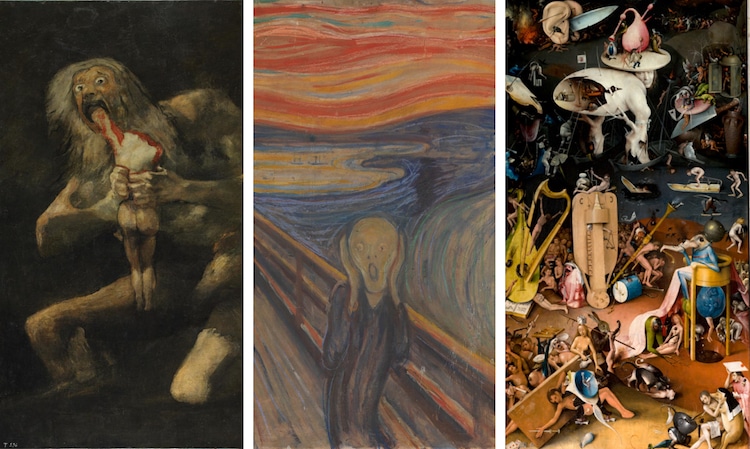
Finally, the Halloween season is here! While tricks, treats, and other goodies offering a conventional manner to gloat the spookiest fourth dimension of the year, nosotros like to get creative while we get into the vacation spirit. And then, we've conjured up a spellbinding option of art history's scariest masterpieces.
Featuring symbolic skulls, smiling spiders, and one very famous Scream, this fine art collection is certain to dazzle art lovers and scare-seekers alike this haunted holiday—one pilus-raising work of fine art at a time.
To celebrate the spooky season of Halloween with an art history twist, we've put together a spine-tingling selection of scary fine art.
A Spooky Still Life
Modern art master Paul Cézanne painted Pyramid of Skulls at the plow of the century. Featuring only a stack of human skulls as its subject, this piece offers an ominous alternative to the artist'due south more traditional yet life paintings of fruits and bottles.
While such eerie iconography was not typical of Postal service-Impressionism, artists had been incorporating skulls and other symbols of mortality into arrangements of objects since aboriginal times. Defined equallymementomori, a Latin title that translates to "remember that you have to die," this genre of painting focuses on the fleeting nature of life.
Every bit he approached old age, Cézanne became increasingly fascinated past death. From 1898 until the end of his life in 1905, Cézanne painted several still lifes of skulls. While about of these depictions do not focus solely on the skeletal objects, Pyramid of Skullsplaces them at the forefront, forcing the viewer to face them and, consequently, reflect upon death. "These bony visages all but attack the viewer," art historian Françoise Cachin said, "displaying an assertiveness very much at odds with the usual reserve of domestic still life tableaux."
A Mythological Monster
Between 1819 and 1823, the Castilian artist Francisco Goya created his Black Paintings, a series of 14 specially haunting pieces. Amidst the almost famous of these frightening works of art is Saturn Devouring His Son , a gruesome painting of a male parent feasting on his kid.
Co-ordinate to Roman mythology, Saturn (Cronus in Greek folklore) was the leader of the Titans. Saturn overthrew his father, Caelus, in an endeavor to become ruler of the universe. Fearing his own offspring would do the same, he killed and consumed each child shortly after birth—an atrocity Goya opted to portray in this Black Painting.
Goya did not create this series for the public. In fact, they were intended to decorate his ain home, with Saturn Devouring His Son hanging—where else?—in the dining room.
Biblical Revenge
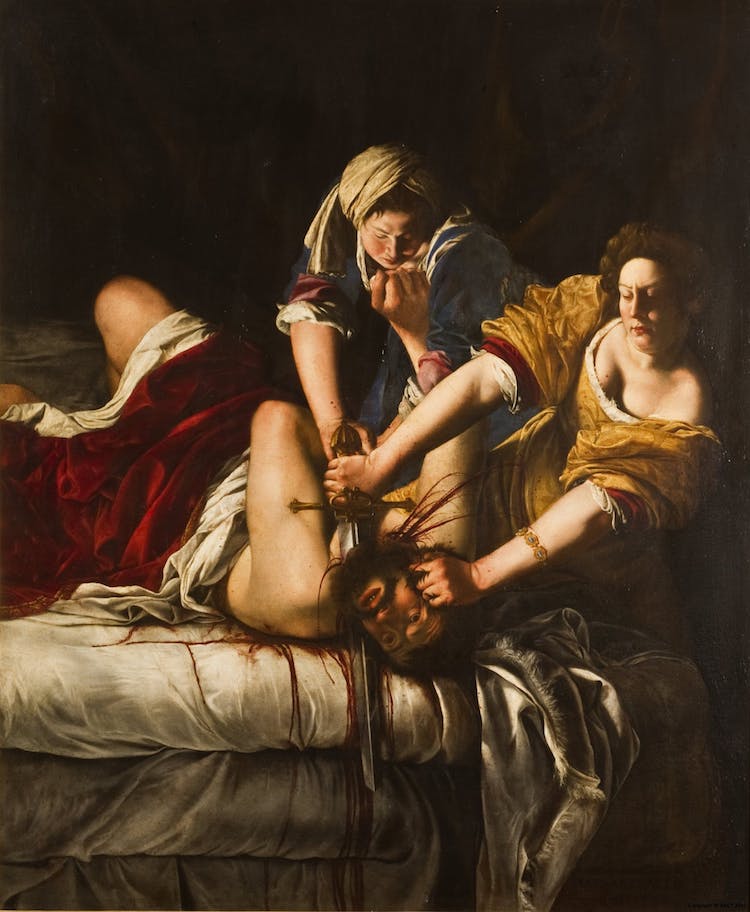
Artemisia Gentileschi, "Judith Slaying Holofernes," 1614–1620 (Photo: Wikimedia Commons, Public domain)
The paintings of Baroque painter Artemisia Gentileschi are characterized by a deep color palette, a skilled use of light and shadow, and, most prominently, an iconographic focus on suffering female figures seeking—and getting—revenge. A painting that typifies this approach is Judith Slaying Holofernes , a masterpiece inspired by a tale from the Old Testament that sees a vengeful widow decapitating a threatening human being.
When contextualized (inside the context of the bible), Gentileschi's decision to portray the gory scene in graphic detail is not particularly unusual—specially for drama-loving Bizarre artists. What sets Judith Slaying Holofernes autonomously from other allegorical paintings of the flow, notwithstanding, is that Gentileschi nigh likely snuck a sneaky portrait into the grisly slice, every bit the slain Holofernes bears a striking resemblance to Agostino Tassi, a young man Italian artist who raped Gentileschi when she was 17 years old.
An Electrifying Event
In the early 1960s, Pop Fine art founder Andy Warhol pioneered silkscreen painting. Crafted using a combination of acrylic paint and the silkscreen method—a mechanical printmaking procedure in which the artist transferred paintings on sail onto newspaper–these works immune the artist to interpret photographs every bit multiple, "mass produced" works.
While Warhol's most famous silkscreen paintings feature popular celebrities and everyday objects as their subjects, his series took a darker plow in 1962, when he started his Death and Disasters series. Featuring everything from devastating car accidents to poisonous cans of tuna to a Big Electric Chair(a painting inspired by a press photograph from the prison where Julius and Ethel Rosenberg were executed), this drove of works speaks to Warhol's morbid interest in—and desensitization to— electric current events.
"When you see a gruesome moving picture over and over again," the artist said, "it doesn't really have an effect."
Mysterious Memories
Mexican painter Frida Kahlo is known for her collection of 55 self-portraits. While her most well-known works characteristic the artist as an adult, she also portrayed herself as a kid in Daughter with Death Mask (She Plays Solitary) .
This peculiar piece depicts a young girl continuing before a barren landscape. In her hand, she holds a single yellow flower and, on her face, she wears a skull mask. Both of these props are characteristic of Día de los Muertos—or 24-hour interval of the Dead— prompting the viewer to reflect upon themes related to death. Finally, a beastly mask rests at her feet, adding fifty-fifty more than mystery to the chilling painting.
Girl with Expiry Mask (She Plays Solitary) was painted in 1938—the year before her dramatic divorce from fellow artist Diego Rivera. Like many works created during this time, this piece was likely inspired by Kahlo's feelings of isolation and loneliness. "I paint self-portraits considering I am so often lone," the artist famously said, "because I am the person I know best."
Visited by the Skeleton Specter
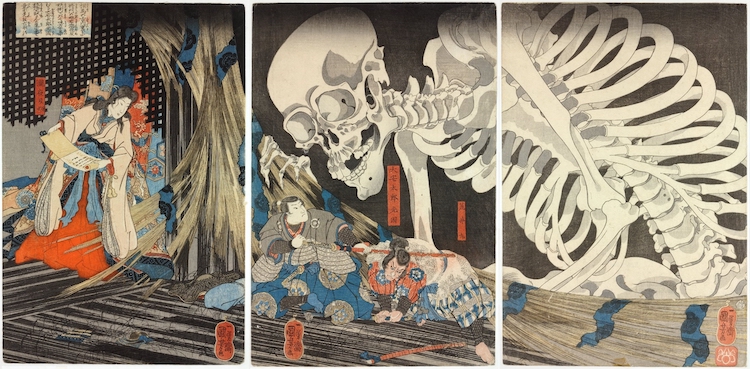
Utagawa Kuniyoshi, "Takiyasha the Witch and the Skeleton Specter" c. 1844 (Photo: Wikimedia Eatables, Public domain)
Edo catamenia artist Utagawa Kuniyoshi created the woodblock print Takiyasha the Witch and the Skeleton Specter, in which a giant skeleton looms over two samurais as a adult female reads a scroll in the wings. The unsettling image is based on a story from the Heian flow in Japan that took place in 939 CE.
At that time, samurai warlord Taira no Masakado traveled from his home in Kantō and led an army to rally against the cardinal regime in Kyoto. He eventually tried to gear up an "Eastern Courtroom" in Shimōsa Province only was defeated and decapitated. His girl, Princess Takiyasha, continued to live in the family's shōen, turning to witchcraft and studying dark magic.
Kuniyoshi's piece shows her reading a spell to bring forth a Gashadokuro, a spirit that takes the form of a giant skeleton. It looks over Ōya Taro Mitsukuni and another samurai who were both sent to go the princess. Their plans were foiled past the haunting spirit.
A Creepy-Awesome Creature
In 1887, French Symbolist artist Odilon Redon created The Smiling Spider , a lithograph of an unusual arachnid with ten legs. Withal, even with this extra gear up of limbs, the most peculiar thing most this spider is its unsettling grin, which the artist has delineated with a row of tiny teeth.
The Smile Spider is 1 of manynoirs, or "blacks" created by Redon betwixt 1870 and 1890. Rendered in charcoal and as lithographs, these pieces illustrate the creative person'southward interest in the obscure and, near importantly, are characterized by darkness—both in colour and subject affair.
"Black is the most essential color," Redon said. "It conveys the very vitality of a being, his energy, his listen, something of his soul, the reflection of his sensitivity. One must respect black. Zip prostitutes it. It does not please the centre and it awakens no sensuality. It is the agent of the heed far more the most beautiful colour of the palette or prism."
A "Scream Passing Through Nature"
Expressionist artist Edvard Munch is renowned for his night and dreary paintings and prints. From 1893 until 1910, he produced his nigh famous masterpiece, TheScream , as a serial of four works.
During this 17-year period, Munch recreated The Scream in crayon, tempera pigment, and oil pastel. While the mediums vary from piece-to-piece, each one features the same subject affair: a mysterious effigy standing on a span and property his face as he screams.
While this scene appears dream-similar, it was actually inspired by a real-life location and a particularly frightening phenomenon. "One evening I was walking along a path, the city was on one side and the fjord below," Munch wrote in his diary. "I felt tired and ill. I stopped and looked out over the fjord—the sun was setting, and the clouds turning blood red. I sensed a scream passing through nature; it seemed to me that I heard the scream. I painted this picture, painted the clouds as actual blood. The colour shrieked. This became The Scream."
A Bad Dream
Henry Fuseli was a leading figure of Romanticism, a 19th-century art movement defined by dreamy iconography. In his most famous (and aptly named) painting, The Nightmare , Fuseli delves into the scary side of the subconscious.
This spine-tingling work of fine art shows a sleeping woman with an incubus—a male demon that preys upon women as they slumber—perched on her torso. A ghostly horse emerges from behind a red velvet pall, forming the only perceivable part of the blackened background.
Most art historians believe that The Nightmare was inspired by German folktales. According to legend, men who slept lone were visited by horse specters, while lone women were possessed by demons or the devil. By incorporating both of these frightening figures in the composition, Fuseli visually represents the manifestation of a living nightmare.
Death is Victorious
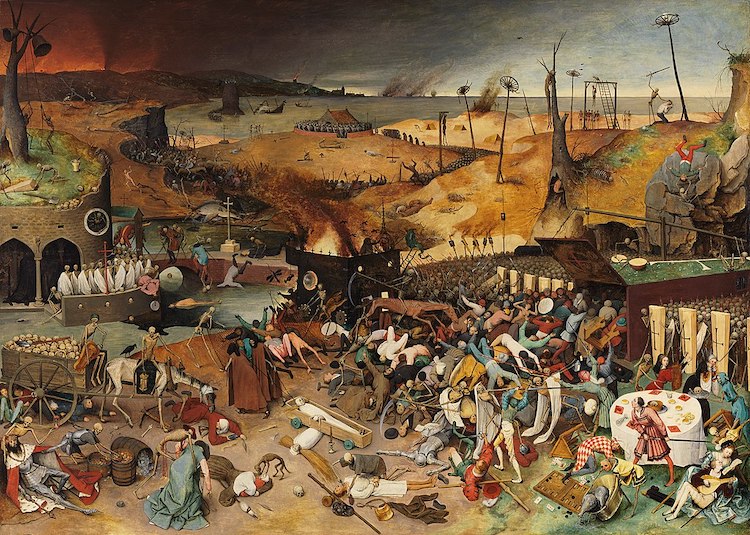
Pieter Bruegel the Elderberry, "The Triumph of Expiry" 1562 (Photo: Wikimedia Eatables, Public domain)
For many, few things are scarier than expiry itself. In Pieter Bruegel the Elder's 1562 paintingThe Triumph of Death, an ground forces of skeletons consumes the barren landscape that's on burn and absolutely wrecked. The ground forces destroys the living and they accept no chance of achieving salvation. Highly detailed and gruesome, the piece begs a long wait to truly have in the unsettling sights of pure chaos.
This piece was a "moral work" by Bruegel and influenced past the idea of the Dance of Death. Also chosen the Danse Macabre, it'due south based on a medieval creative allegory that death unites the states all, no matter our station in life.
A Monstrous Beauty
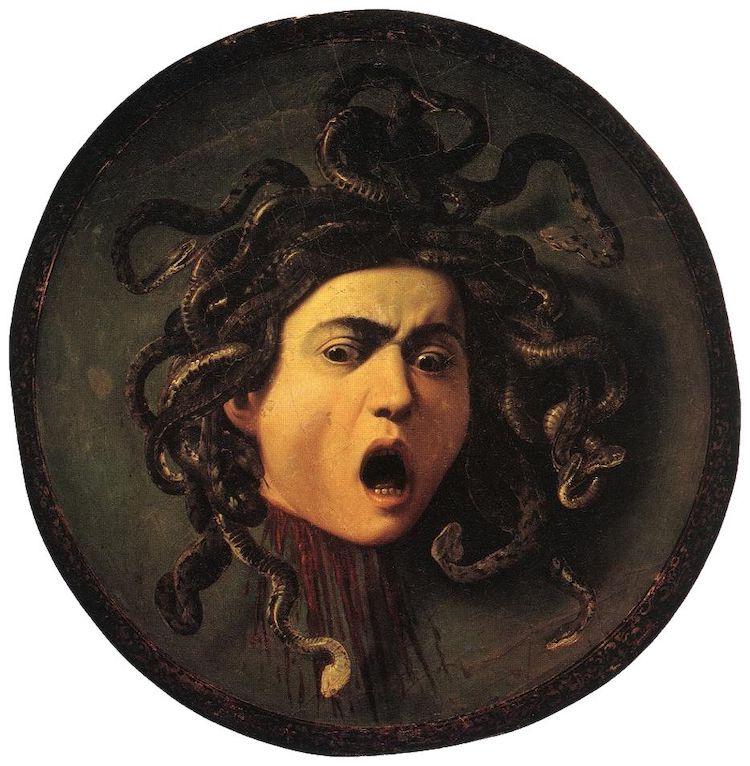
Michelangelo Merisi da Caravaggio, "Medusa," 1597 (Photograph: Wikimedia Commons, Public domain)
Caravaggio drew on the ancient Greek myth of Medusa for this frightening painting. Information technology depicts the severed caput of Medusa, a mythical monster who's described equally a female adult female with statuary hands and endless venomous snakes for hair. Legend has it that anyone who fifty-fifty so much as glanced at her would be turned to stone. Medusa was cursed by the Greek goddess Athena, who turned her into the venomous monster she became. Perseus, son of Greek god Zeus and princess Danae, decapitated Medusa using a shield given by Athena.
Caravaggio made two versions of his Medusa painting—1 in 1596 and the other in 1597. In this work, Caravaggio used a mirror and painted his own face in the place of Medusa. He did so to indicate his immunity to her terrified expression. Though the caput is decapitated, it even so appears conscious, capturing Medusa'south last horrific moments. Claret pours out from her severed neck, while her mouth hangs wide open up, baring teeth.
A Surreal Scene
Though he lived 500 years ago, Hieronymus Bosch remains the principal of the macabre. The Early on Netherlandish Renaissance artist is known for his surreal paintings of otherworldly settings—like the fantastic and frightening Garden of Earthly Delights.
While little is known about the origins of this this topsy-turvy triptych, it remains Bosch's nigh resonant works of art. Featuring hybrid animals, brand-believe machines, and everything in between, the chaotic painting strikes a perfect balance between eye-catching peculiarity and nightmare-inducing horrors—especially when observed in item.
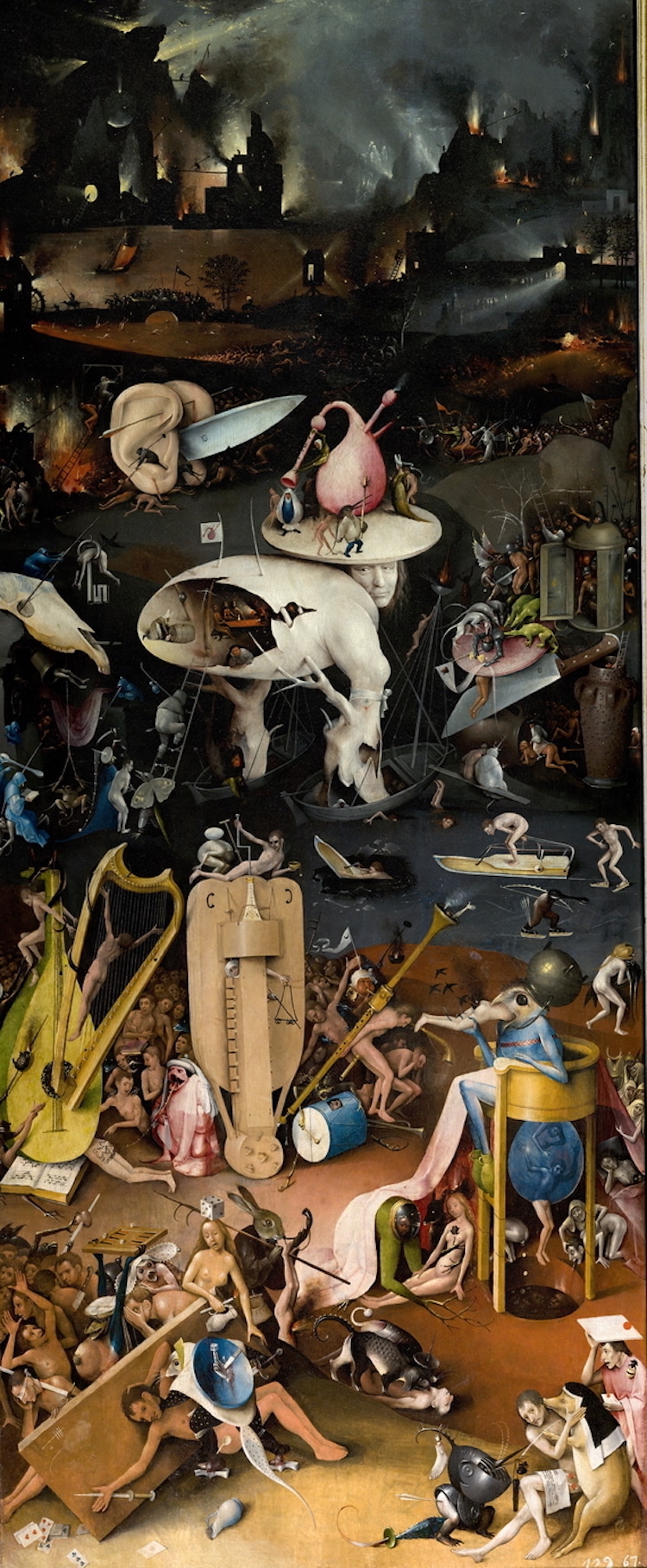
Hieronymus Bosch, "The Garden of Earthly Delights," c. 1500–1505 (Detail)
A whimsical estimation of the Bible's Story of Creation, the Garden of Earthly Delights proves that whatever subject tin can be scary if given a surreal twist.
This commodity has been edited and updated.
Related Manufactures:
28 Frighteningly Fun DIY Kits and Crafts for Halloween
lx+ Artistic Halloween Makeup Ideas to Inspire Your Adjacent Spooky Await
31 Halloween Pumpkin Carving Ideas to Creatively Celebrate the Spookiest Time of Twelvemonth
Source: https://mymodernmet.com/scary-art/
0 Response to "What Is the Most Disturbing Type of Modern Art Called"
Postar um comentário